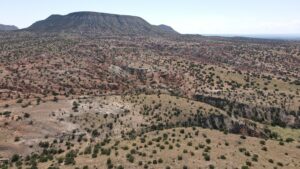Chupadera Mesa

January 16, 2025
An innovative partnership between the New Mexico Land Conservancy (NMLC), New Mexico State Land Office (SLO), and Department of Defense (DoD) just protected 60,000 acres of Chupadera Mesa in central New Mexico’s Greater White Sands ecoregion—including the remnants of the 195-room Seco Pueblo.
“Protection of Chupadera Mesa isn’t just one of largest land conservation projects in the state, it’s a testament to the power of collaboration and the deep respect we have for the cultural heritage embedded in this landscape,” said Jonathan Hayden, Executive Director of the New Mexico Land Conservancy. “By protecting these invaluable resources, we honor the stories and traditions of those who came before us while ensuring that future generations can continue to connect with this land’s rich history.”
The Chupadera Mesa area contains a wealth of cultural resources dating back 1,200 years, to a time when the land was home to the Jornada Mogollon people. As late as 1583, Spanish explorer Antonio Espejo reported that this area has “eleven pueblos with a great many people, over 40,000.” While drought ultimately forced many of the pueblos to flee the area in the 1660s, remnants of their way of life are scattered across Chupadera Mesa’s pinon-juniper highlands and rugged canyons.
In addition to cultural resources, Chupadera Mesa also contributes to an interconnected landscape of wildlife habitat home to elk, mule deer, pronghorn, mountain lion, bobcat, fox, coyote, rattlesnake, and numerous migratory bird species.
This incredibly rich landscape is now protected thanks to the collaboration between NMLC, SLO, and DoD to restrict development through DoD’s Readiness and Environmental Protection Integration (REPI) Program. REPI is a unique DOD program that works to protect high-priority military missions by helping relieve or avoid land-use conflicts near military facilities, promote natural resource conservation and habitat protection to mitigate restrictions that inhibit military activities, and prepare for climate change impacts by enhancing military installation resilience.
“This agreement shows that diverse entities actually can work together to protect our most valuable resources,” said New Mexico State Land Commissioner Stephanie Garcia Richard. “The agreement also ensures the U.S. military can continue its work that is vital to keeping all of us safe. As the daughter of a veteran, I’m thrilled that state lands can contribute to our national security while providing a new source of funding for our schools.”
Chupadera Mesa includes a large part of the northern buffer of the White Sands Missile Range, and therefore was highly desirable for protection by the U.S. Army, which administers the two-million-acre range.
“This is a great “win” for everyone involved,” said Brian Knight, Environmental Division Chief at White Sands Missile Range. “The execution of this agreement not only protects our State’s cultural and natural resources, but it provides a source of revenue to assist the State Land Office mission and protects critical airspace for the military test and evaluation which is a crucial component of our national defense.”
“The protection of Chupadera Mesa is truly a win-win-win for national defense, wildlife, and New Mexico’s unique cultural heritage,” said Hayden.

